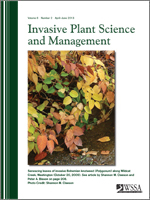The interactive effects of herbivory, exotic species, and other human-mediated changes to the biosphere are reducing species diversity and altering ecosystem services globally. In this study, we tested whether facilitation could be used as a management technique to restore a degraded northeast Wisconsin forest understory facing high white-tailed deer (Odocoileus virginianus) browse pressure and high abundance of the exotic herb garlic mustard [Alliaria petiolata (Bieb.) Cavara & Grande]. Specifically, we attempted to facilitate native understory restoration by planting or seeding native herbs into three different matrix densities of the native, browse-tolerant grass Virginia wildrye (Elymus virginicus L.), which were either protected from (fenced), or accessible to, deer browsing. Deer had minimal impacts on E. virginicus but significantly reduced the cover, survival, and flower production of white snakeroot [Ageratina altissima (L.) King & H.E. Robins.] transplants, largely independent of the density of E. virginicus plantings in open-access plots. In contrast, the richness and abundance of native-seeded species were not affected by deer access but were reduced by increasing E. virginicus densities. Alliaria petiolata cover was significantly higher in plots accessible to deer but declined significantly with increasing E. virginicus planting density in both open-access and fenced plots. These results were largely corroborated by results from an associated observational study, with the exception that natural E. virginicus stands supported slightly higher native-species richness than did adjacent areas lacking E. virginicus. Thus, although we found little support that establishing E. virginicus facilitated browse-susceptible native understory herbs during our short-term experimental study, restored E. virginicus successfully established, thereby increasing native species cover and significantly reducing the cover of the exotic A. petiolata. We suggest the planting of browse-tolerant native species, such as E. virginicus, as a viable restoration technique in heavily browsed, A. petiolata–invaded woodlands.
Nomenclature: Garlic mustard, Alliaria petiolata (Bieb.) Cavara & Grande, Virginia wildrye, Elymus virginicus L., white snakeroot, Ageratina altissima (L.) King & H.E. Robins
Management Implications: Ecological theory should be used as the basis for developing low-cost, self-perpetuating, restoration techniques that delay, halt, or counter local biodiversity declines and exotic plant invasions. In this study, we investigated the potential for transplanting an unpalatable native grass into an overbrowsed, invaded understory in northeast Wisconsin to facilitate increases in native plant richness and cover and to simultaneously reduce the abundance of the exotic herb garlic mustard (Alliaria petiolata). As expected, the native grass successfully tolerated white-tailed deer browsing, increasing overall native plant cover and significantly reducing A. petiolata cover. In fact, the density of our highest native-grass planting completely offset the seemingly stimulatory effects of white-tailed deer on A. petiolata cover. However, we found little to no support that establishing the native grass promoted increases by other native species. Nevertheless, our results suggest a promising avenue for invasive species management, where restoration goals may often better align with ecosystem stabilization or exotic remission than they do with full ecosystem recovery. Native grass seed and transplants are relatively cheap and, thus, could be economically applied throughout large areas. Should the trends we report be maintained, establishing native grasses may also serve as a sustainable approach f





